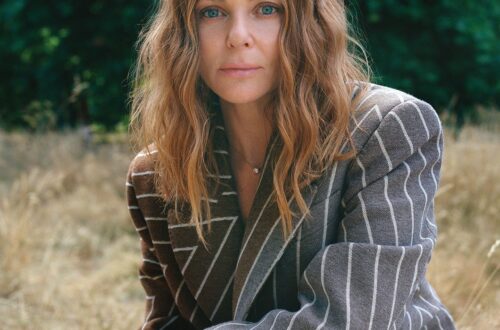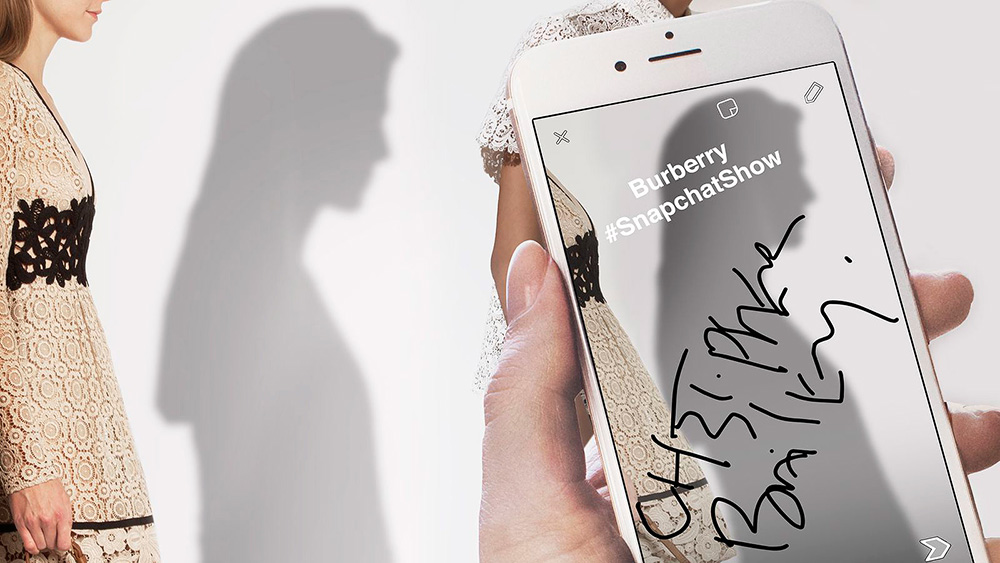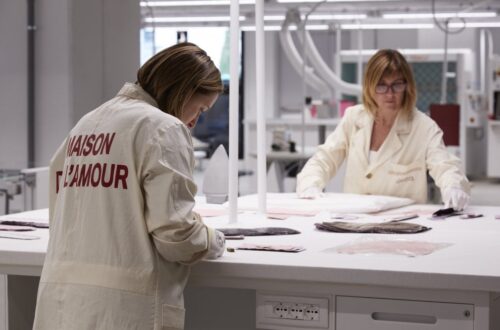
What does it mean to be a feminine brand? Is there a strict opposition between femininity and feminism? Should fashion be a vehicle for political and social ideas? Such questions are perpetually being revisited by the designers of the foremost high fashion houses.
Since 2016, Dior’s ninth, or should we say first woman, creative director, Maria Grazia Chiuri (MGC) audaciously blends fashion and feminism. Both back and front stage, the Italian designer sticks to her relentless commitment to empower women. At the heart of her leadership is the strong, collective assertion of what it means to be a woman today, thereby re- and auto-defining femininity.
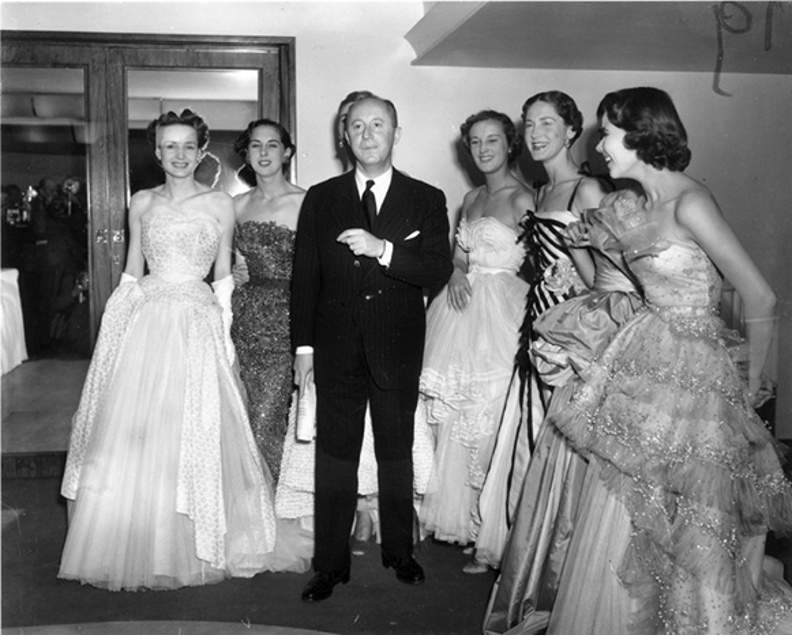
The historical Maison flourished when Monsieur Dior designed “clothes for flower-like women” tapping into the post-war nostalgia of France’s Belle Epoque, with fuller petal-like skirts over the hips, from a handspan waist to long hemlines. After years of wartime austerity, Christian Dior sought to erase any signs of the recent bloodshed conveyed in clothes, like utilitarian androgynous bottoms – short skirts and pants – and uniform-like boxy shoulders.
Each of his creations was a testament to his love of women, meant to empower them and enable them to express their individuality. His New Look revolutionized fashion. It ushered in a new era where women could reclaim and celebrate their personality and femininity with confidence.
But because his vision of femininity remained anchored in glamour, luxurious and abundant use of fabric, and accentuating female forms, his designs also had their critics.
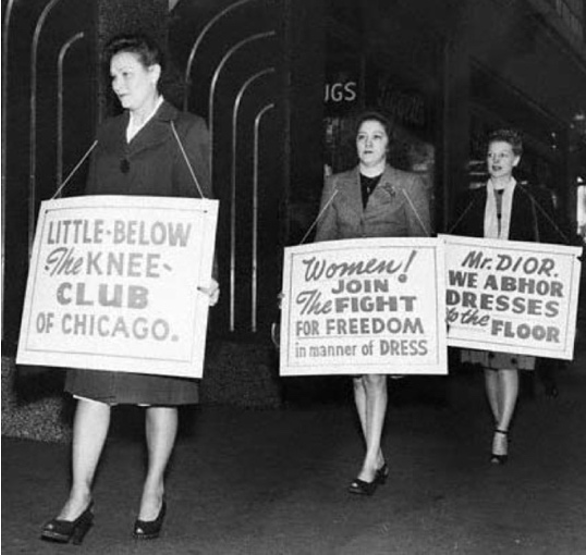
The notable Little Below The Knee Club born in Texas grew all the way to the other side of the Atlantic, in Paris, where women protested against what they considered an old-fashioned look imagined by the rising French couturier nicknamed “The Tyrant of Hemlines”.
“GRANMA WORE THIS!”. “WE WON’T REVERT TO GRANMA’S SKIRT”.
This revolt against longer skirts represented more than a mere style preference, it signaled a resistance against stepping backwards in terms of female emancipation by impelling women to take part in impractical fashion trends.
Thereupon, Christian Dior’s vision of women and femininity was oftentimes associated with lightness and seduction, a standpoint which did not resonate with all women.
Coco Chanel opined: “Dior doesn’t dress women, he upholsters them”, suggesting he did not know women.
Ironically, fast forward today, in the current exhibition “Louvre Couture” in Paris, one of the most feminine yet modern and powerful dresses exposed is a Dior MGC design inspired by a medieval tapestry. Which goes to prove that today more than ever, paying homage while transcending a brand’s DNA is way more subtle and complicated an exercise.
Longing for an idealized past is not Maria Grazia Chiuri’s way of proceeding. She looks to the future: always building on references to the rich legacy of the house but always making sense of them in a contemporary way.
“Dior has to be about female empowerment. Only with flowers? It’s not enough.” stated the Italian designer to British Vogue.
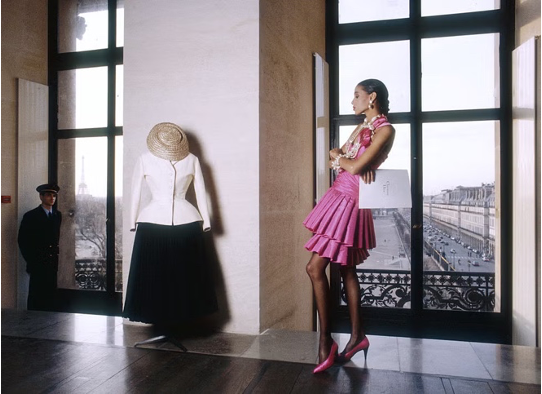
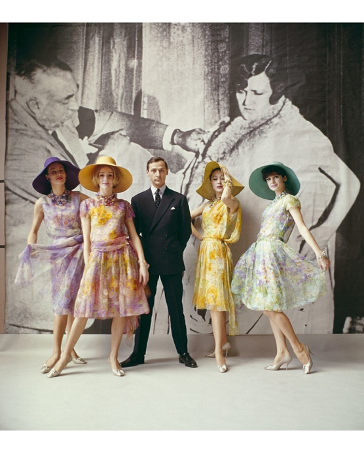
Chiuri is more inspired by Marc Bohan’s era at Dior. His revolutionary flowy, shorter cut collections showcased his understanding of the changing needs of modern women, as he began to free their bodies.
“I make clothes for real women, not myself, not for mannequins and not for fashion magazines” had declared the quiet French designer at the reins of the brand for three decades.
In the same vein, Maria Grazia Chiuri is convinced that a dialogue must be set up with the new generation. A dialogue based on values, not solely clothes. In here lies the true power of fashion: its unique position as an emotionally-engaging craft and social phenomenon. Through her female gaze, Chiuri praises the fact that all women are different. They therefore can and must be represented in a multifaceted fashion: strong, soft, beautiful, smart, active, wild… and most importantly free. In the Maison’s ninth era, “there is no “ultimate” Dior woman”. Chiuri’s outlook on fashion is one of independence, self-sufficiency, raging fearlessness and confidence, where all women have a seat at the table.
As a matter of fact, Maria Grazia Chiuri carries a tenacious devotion to make women heard and seen – every step of the way of the creative process. From conception to runway.
When writing the new page of Dior’s femininity, the creator begins her story by joining forces with brilliant craftswomen, or “bees” as Monsieur Dior would call them – the people at the genesis of the fabulous creations.
Historically, women were expected to be dressmakers, while men became couturiers. MGC herself never had dreamt of assuming her current role, as no woman had ever been at the helm of the eminent fashion house.
Still, Maria Grazia was raised knowing that fashion and feminism are threaded together. Her mother was a seamstress and cherished her experience in the atelier shared with other women who, regardless of social classes, helped her learn more about herself and educated her. Furthermore, the 5 Fendi sisters, veritable mentors of the Italian designer, showed her a sense of sisterhood in the creation of clothes. Always speaking in plural, they assert themselves as one: “WE are a team”, “WE are the women”.
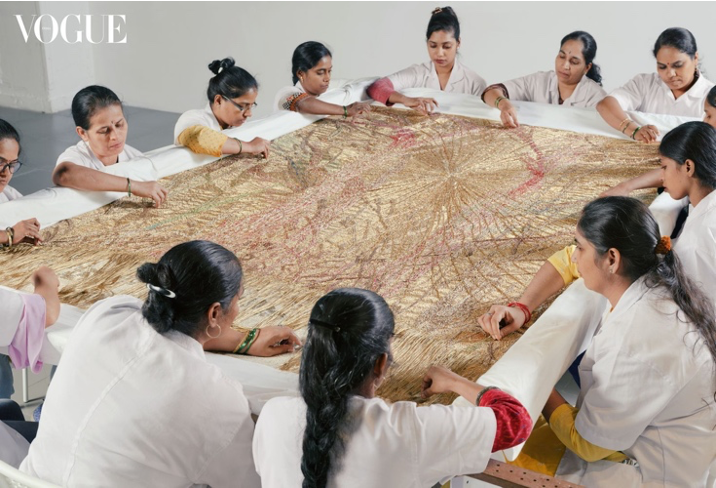
In that spirit MGC decided Dior would sponsor the Chanakya School of Craft in India, an academy that teaches embroidery to women, an occupation which used to be exclusively masculine. Safeguarding and reasserting artisanal savoir-faire is a matter particularly dear to the Italian designer. As craftsmanship techniques are mostly passed down between women, they have been considered domestic and without any cultural value. Dior seeks to retell and celebrate the stories behind this work in a louder voice using its far-reaching visibility. By collaborating with artists, the students understand that they are not just executors, they get to create works of art and express themselves – they learn how to become artists themselves.
In such manner, Dior’s battle against patriarchy resides in the construction of a global female identity, a community of entitled women, founded on solidarity.
Besides the handicraft, at Dior, all campaigns are shot exclusively by female photographers. This contentious policy is aimed at refocusing the lens away from the male gaze, to put an end to the objectifying of women. How women are pictured in fashion and more generally the media plays a key role in the regard of women in society. Presenting a feminist perspective in advertising relates closely to Maria Grazia Chiuri’s trailblazing vision of fashion, as an activist project, not merely related to a specific body, person or age. Just like handbags, eyewear or footwear, for the former accessory designer of Valentino, on top of who uses it, the creation is about its broader functionality.
Feminist messages abound in every Dior collection. Bold words disclosed on textile: this is Maria Grazia Chiuri’s weapon of predilection in creating riveting shows, both in the clothes and their surroundings.
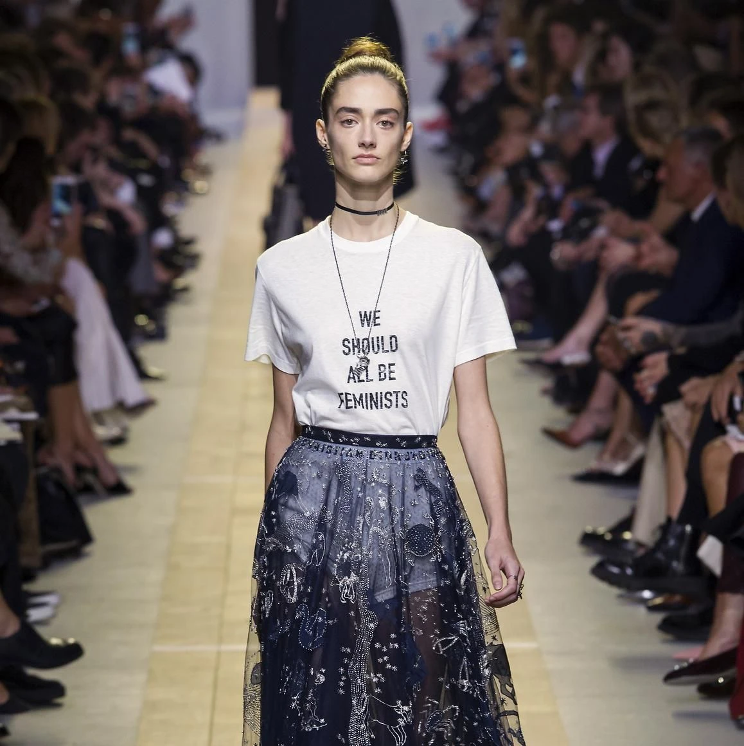
Since her very first runway show at Dior, on the most simple form of fashion – a plain-cut white cotton t-shirt – Chiuri has been making a statement: “WE SHOULD ALL BE FEMINISTS”, breaking with convention. Chimamanda Ngozi Adichie’s indisputable motto could not be more ready-to-be-taken on. The enthusiasm around the bold debut collection paved the way for a series of awe-inspiring runway shows, designed teaming up with pioneers in feminist art.
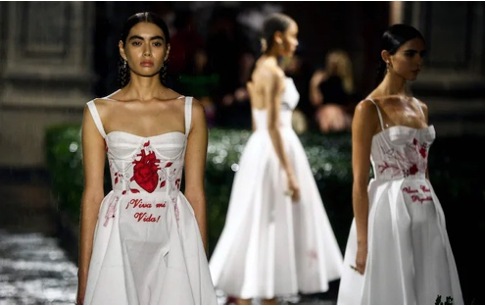
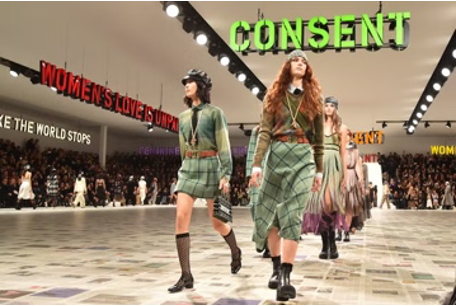
All over the world, the designer shares her cutting-edge vision. In Mexico – a country where patriarchal values are still ruling to this day – the 2024 Cruise Collection featured a finale of liberating sentences in a red thread, in homage to the too many women victims of feminicide, like fellow engaged artist Elina Chauvet’s sister. MGC’s sucessful performance in 2020 forever marked the New York Fashion Week. Picture this: the day after the conviction of Harvey Weinstein, guilty of rape and criminal sexual assault, neon signs proclaimed: “CONSENT”. “CONSENT”. “CONSENT”.
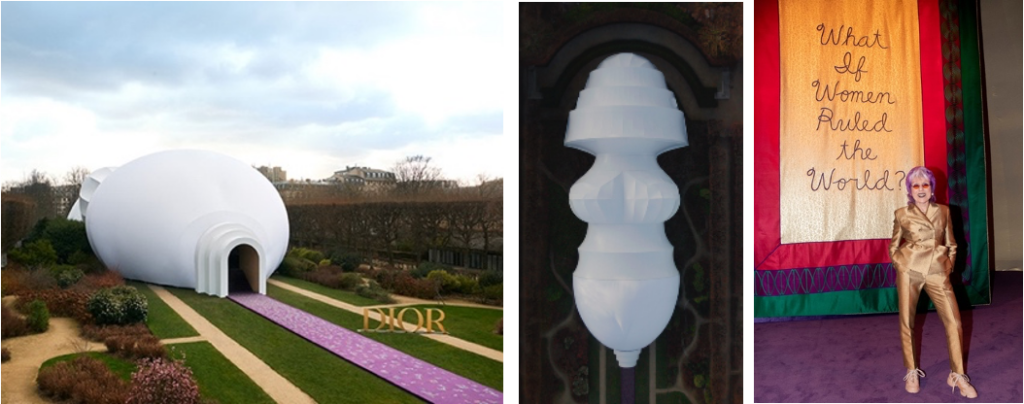
View of the Goddess structure, the site of Dior’s 2020 Spring Summer haute couture show by MGC (middle)
Judy Chicago, in front of one of her banners inside the show space (right)
Following such happenings and with an audience like Dior’s, installations are able to scale up, like Judy Chicago’s Divine Feminine, a massive sculpture in the shape of a woman’s body. Only, when two ambitious artists unite with the aim to change the world, they tend to face adversity. Undoubtedly, critics sparked, as the guests had to enter the show through the birth canal. It remains nevertheless hard to think of a more literal celebration of womanhood.
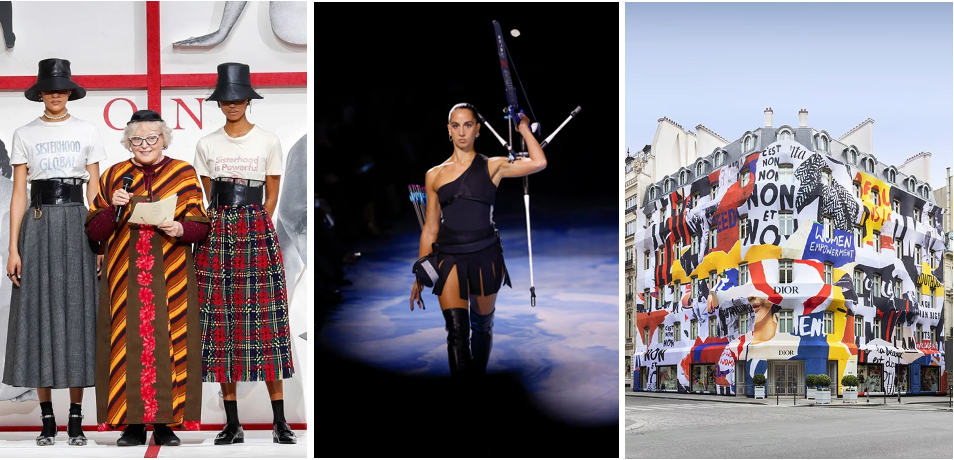
SAGG Napoli at the Dior Spring-Summer 2025 at Paris Fashion Week by MGC (middle)
Dior Paris flagship 30 avenue Montaigne, transformed into a protest banner for the Fall-Winter 2018 show by MGC (right)
In her most recent défilés, Maria Grazia Chiuri proved that she is determined to keep going. Dior’s opening of the Paris Fashion Week, a theatrical manifestation of female power and multiplicity, was spot on, just a few months after the Olympic Games, as a competitive archer proceeded with a swagger on the catwalk then shot her arrow right into the bull’s-eye.
Whether it is with stamped feminist manifesto titles on shirts, embroidered combative statements on dresses and tapestries, or symbolically loaded decorative elements, MGC never fights alone to address the gender bias.
All in all, a lot of people disapprove of Chiuri’s collections, a total antithesis to John Galliano’s theatricality, Gianfranco Ferré’s architectural masterpieces, or Raf Simons’s unproblematic sobriety.
Over the years, each designer of the house decided to pay tribute and bring to light one particular strand of the brand’s identity. For MGC, it is the feminist value. Whilst Christian Dior understood that women are multifaceted individuals, Maria Grazia Chiuri seeks to emphasize this with her own words of a 21st century fierce woman. Her positioning and its intensity, together with the timing, generated doubts, even internally, as the focus was on the meanings and symbolics which can be vehicled through couture. Clothes thus become a vector of ideas, filled with purpose, while remaining desirable and wearable.
Precisely, designers have a responsibility to generate a positive impact, beyond revenues, and ought to use their audience with intentionality. For fashion is a medium, and its imprint on society is the end
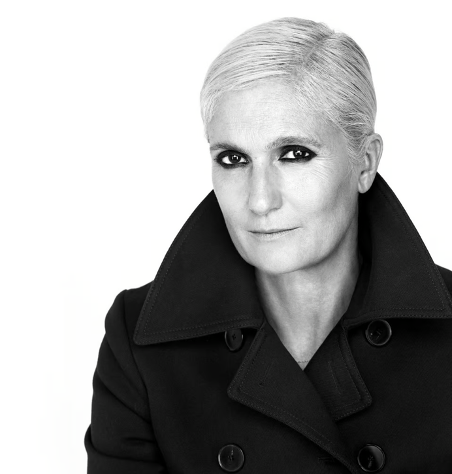
MGC’s singularity resides in her decision to be a forceful voice, no matter the antagonism, for women to have a say in the conversation. Her aspiration is to reclaim the speech on women inasmuch as this right has been taken away for too long. Maria Grazia Chiuri’s Dior will forever be remembered as the demonstration that feminism and femininity can coexist as one.
Overall, Maria Grazia Chiuri’s triumph as creative director of the historical French Maison is entirely praiseworthy, in the sense that she uses her position as a springboard for many women.
Monsieur Dior wished to use his art to spotlight women’s greatness, their grace, force, and uniqueness. However his goal was sometimes mistaken. In Maria Grazia Chiuri, his Maison could not have found a stronger advocate of female empowerment at the helms of Dior, the most feminine of the grand fashion houses. In her quest for feminism, there is no mistaking, even in her most delicate and romantic designs. She is transcending what fashion is and what it could be, breaking the mold, pushing fashion forward and profoundly transforming femininity.
To paraphrase Judy Chicago, What if women ruled (indeed) the (fashion) world?
By Alexia Delcaire
Sources:
- Christian Dior, Dior by Dior, trans. Antonia Fraser (London: V&A Publications, 2007), 22-3
- https://www.missbloom.gr/life/1041695/christian-dior-0-antras-pou-apotheose-tin-gunaikeia-mesi/
- https://www.lipsticklettucelycra.co.uk/blog/2013/04/12/little-below-the-knee-club-2/
- https://www.bbc.com/culture/article/20190129-the-formidable-women-behind-the-legendary-christian-dior
- Exhibition Louvre Couture in Paris
- https://www.vogue.co.uk/article/maria-grazia-chiuri-vogue-interview
- https://wwd.com/feature/the-quiet-man-505185-2024860/
- https://podcasts.dior.com/justine-picardie
- https://ww.fashionnetwork.com/news/Chanakya-school-of-craft-empowering-women-through-embroidery,1502825.html
- https://ww.fashionnetwork.com/news/Empowering-artisans-maria-grazia-chiuri-s-commitment-to-supporting-craftsmanship-through-education,1518883.html
- https://www.youtube.com/watch?v=AIv1qrV3MZg
- https://www.elle.com/fashion/a31105423/dior-fall-2020-show/
- https://www.nytimes.com/2020/01/20/t-magazine/dior-judy-chicago.html
- https://www.theguardian.com/fashion/2024/sep/24/dior-hits-bullseye-with-archery-display-to-open-paris-fashion-week
Images:
Maria Grazia Chiuri and models – Getty Images
Christian Dior Haute Couture Spring-Summer 1987 by Marc Bohan – Julio Donoso, Getty Images
Women in the atelier of the Chanakya School of Craft in India working on ‘The Rising artwork featuring badla embroidery and metallic threads – Vogue
Dior Spring-Summer 2017 by MGC – Elle France, Imaxtree
Dior Cruise Collection 2024 by MGC – Rodrigo Oropeza/AFP, Getty Images
Dior Fall 2020 at New York Fashion Week by MGC – Stephane Cardinale – Corbis, Getty Images
The Female Divine by Judy Chicago for Dior Haute Couture Spring-Summer 2020 Show by MGC – Adrien Dirand, courtesy of Dior
View of the Goddess structure, the site of Dior’s 2020 Spring Summer haute couture show by MGC – judychicago.com, courtesy of Dior
Judy Chicago, in front of one of her banners inside the show space – NYTimes, Kevin Tachman
Tommaso Binga opening the Dior Fall-Winter 2019-2020 show in Paris by MGC – Paris Match
SAGG Napoli at the Dior Spring-Summer 2025 at Paris Fashion Week by MGC – Invision
Dior Paris flagship 30 avenue Montaigne, transformed into a protest banner for the Fall-Winter 2018 show by MGC – FashionNetwork.com
Maria Grazia Chiuri – FashionNetwork.com



